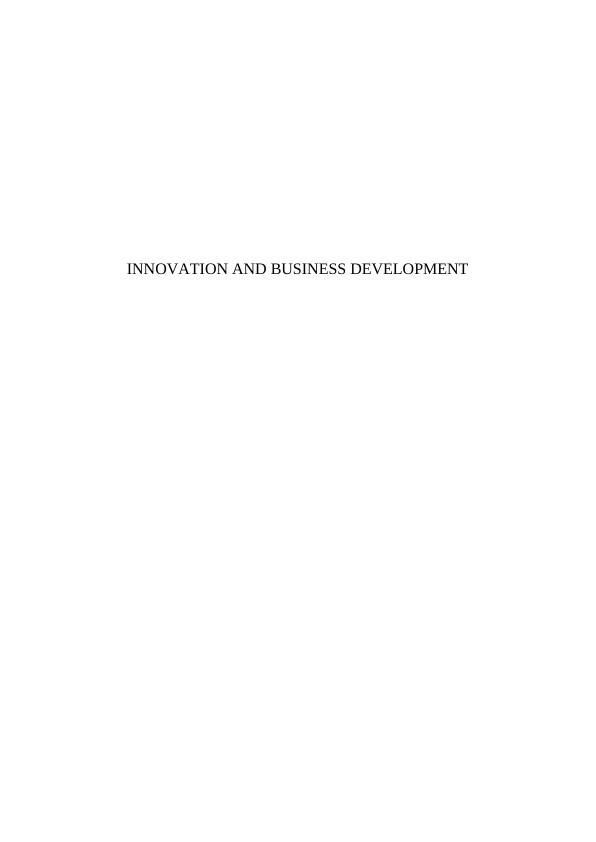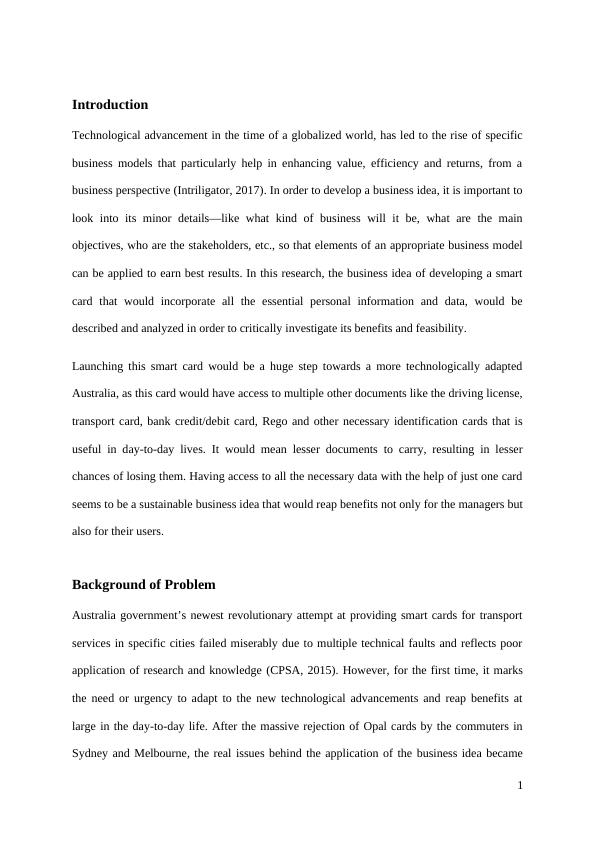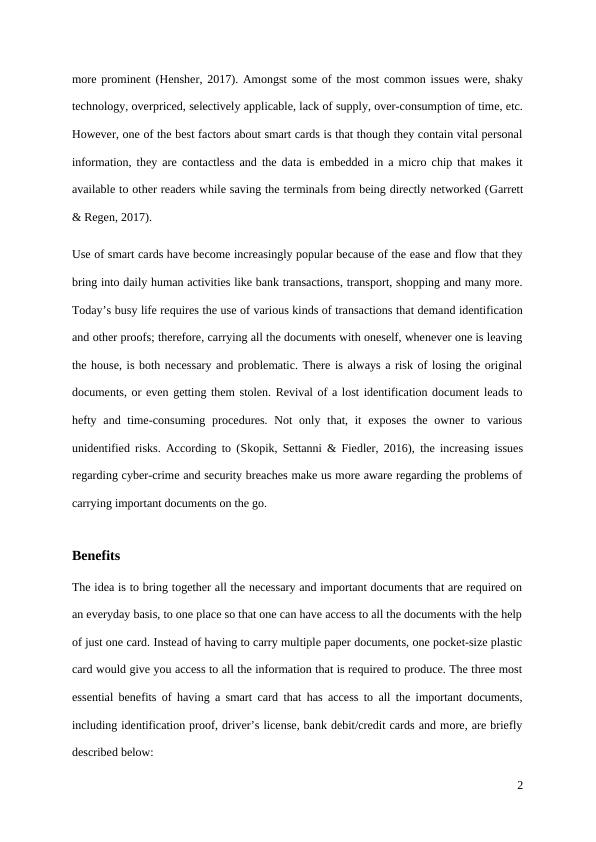Smart Card Business Model: Feasibility and Critical Success Factors
Added on 2023-06-07
12 Pages3035 Words75 Views
INNOVATION AND BUSINESS DEVELOPMENT

Introduction
Technological advancement in the time of a globalized world, has led to the rise of specific
business models that particularly help in enhancing value, efficiency and returns, from a
business perspective (Intriligator, 2017). In order to develop a business idea, it is important to
look into its minor details—like what kind of business will it be, what are the main
objectives, who are the stakeholders, etc., so that elements of an appropriate business model
can be applied to earn best results. In this research, the business idea of developing a smart
card that would incorporate all the essential personal information and data, would be
described and analyzed in order to critically investigate its benefits and feasibility.
Launching this smart card would be a huge step towards a more technologically adapted
Australia, as this card would have access to multiple other documents like the driving license,
transport card, bank credit/debit card, Rego and other necessary identification cards that is
useful in day-to-day lives. It would mean lesser documents to carry, resulting in lesser
chances of losing them. Having access to all the necessary data with the help of just one card
seems to be a sustainable business idea that would reap benefits not only for the managers but
also for their users.
Background of Problem
Australia government’s newest revolutionary attempt at providing smart cards for transport
services in specific cities failed miserably due to multiple technical faults and reflects poor
application of research and knowledge (CPSA, 2015). However, for the first time, it marks
the need or urgency to adapt to the new technological advancements and reap benefits at
large in the day-to-day life. After the massive rejection of Opal cards by the commuters in
Sydney and Melbourne, the real issues behind the application of the business idea became
1
Technological advancement in the time of a globalized world, has led to the rise of specific
business models that particularly help in enhancing value, efficiency and returns, from a
business perspective (Intriligator, 2017). In order to develop a business idea, it is important to
look into its minor details—like what kind of business will it be, what are the main
objectives, who are the stakeholders, etc., so that elements of an appropriate business model
can be applied to earn best results. In this research, the business idea of developing a smart
card that would incorporate all the essential personal information and data, would be
described and analyzed in order to critically investigate its benefits and feasibility.
Launching this smart card would be a huge step towards a more technologically adapted
Australia, as this card would have access to multiple other documents like the driving license,
transport card, bank credit/debit card, Rego and other necessary identification cards that is
useful in day-to-day lives. It would mean lesser documents to carry, resulting in lesser
chances of losing them. Having access to all the necessary data with the help of just one card
seems to be a sustainable business idea that would reap benefits not only for the managers but
also for their users.
Background of Problem
Australia government’s newest revolutionary attempt at providing smart cards for transport
services in specific cities failed miserably due to multiple technical faults and reflects poor
application of research and knowledge (CPSA, 2015). However, for the first time, it marks
the need or urgency to adapt to the new technological advancements and reap benefits at
large in the day-to-day life. After the massive rejection of Opal cards by the commuters in
Sydney and Melbourne, the real issues behind the application of the business idea became
1

more prominent (Hensher, 2017). Amongst some of the most common issues were, shaky
technology, overpriced, selectively applicable, lack of supply, over-consumption of time, etc.
However, one of the best factors about smart cards is that though they contain vital personal
information, they are contactless and the data is embedded in a micro chip that makes it
available to other readers while saving the terminals from being directly networked (Garrett
& Regen, 2017).
Use of smart cards have become increasingly popular because of the ease and flow that they
bring into daily human activities like bank transactions, transport, shopping and many more.
Today’s busy life requires the use of various kinds of transactions that demand identification
and other proofs; therefore, carrying all the documents with oneself, whenever one is leaving
the house, is both necessary and problematic. There is always a risk of losing the original
documents, or even getting them stolen. Revival of a lost identification document leads to
hefty and time-consuming procedures. Not only that, it exposes the owner to various
unidentified risks. According to (Skopik, Settanni & Fiedler, 2016), the increasing issues
regarding cyber-crime and security breaches make us more aware regarding the problems of
carrying important documents on the go.
Benefits
The idea is to bring together all the necessary and important documents that are required on
an everyday basis, to one place so that one can have access to all the documents with the help
of just one card. Instead of having to carry multiple paper documents, one pocket-size plastic
card would give you access to all the information that is required to produce. The three most
essential benefits of having a smart card that has access to all the important documents,
including identification proof, driver’s license, bank debit/credit cards and more, are briefly
described below:
2
technology, overpriced, selectively applicable, lack of supply, over-consumption of time, etc.
However, one of the best factors about smart cards is that though they contain vital personal
information, they are contactless and the data is embedded in a micro chip that makes it
available to other readers while saving the terminals from being directly networked (Garrett
& Regen, 2017).
Use of smart cards have become increasingly popular because of the ease and flow that they
bring into daily human activities like bank transactions, transport, shopping and many more.
Today’s busy life requires the use of various kinds of transactions that demand identification
and other proofs; therefore, carrying all the documents with oneself, whenever one is leaving
the house, is both necessary and problematic. There is always a risk of losing the original
documents, or even getting them stolen. Revival of a lost identification document leads to
hefty and time-consuming procedures. Not only that, it exposes the owner to various
unidentified risks. According to (Skopik, Settanni & Fiedler, 2016), the increasing issues
regarding cyber-crime and security breaches make us more aware regarding the problems of
carrying important documents on the go.
Benefits
The idea is to bring together all the necessary and important documents that are required on
an everyday basis, to one place so that one can have access to all the documents with the help
of just one card. Instead of having to carry multiple paper documents, one pocket-size plastic
card would give you access to all the information that is required to produce. The three most
essential benefits of having a smart card that has access to all the important documents,
including identification proof, driver’s license, bank debit/credit cards and more, are briefly
described below:
2

1. Security: Ability to provide a securely encrypted storage is one of the most valuable
benefits of smart cards. Though they hold a substantial amount of private data and
information, the data cannot be retrieved or read by anyone without the user’s
permission, secured by a private and unique code or PIN (Kumari et al., 2017).
2. Online portals: The smart cards are individually connected to each individual’s online
portal, which they can access from anywhere, at any time, with basic internet on a
phone/ tablet/ computer. These online portals would provide adequate guidance and
information to the users, regarding their latest activities, transactions,
recommendations and further insights.
3. Sustainable: One of the long-term benefits of using smart cards would be conservation
of time and resources. As the use of smart cards make transactions relatively easier by
connecting most of the relevant data at one go, it will save a considerable amount of
time in various sectors like, transportation, travelling, shopping, identification and
many more (Beck et al., 2016). With reduced use of paper documents and most
transactions online, it would also conserve a sustainable amount of energy and
resources.
Proposed Business Model
The proposed business idea is to implement the technological advancements of the country
into the day-to-day transactions, so as to simplify the transaction methods and also make
them more secure. This smart card would contain valuable personal data and information,
linked to the original documents and supported by an online portal system. The motive is to
allow easy access to important documents without having to carry original hard-copies
physically. With a secure encryption method, the data can only be partially retrieved or read,
3
benefits of smart cards. Though they hold a substantial amount of private data and
information, the data cannot be retrieved or read by anyone without the user’s
permission, secured by a private and unique code or PIN (Kumari et al., 2017).
2. Online portals: The smart cards are individually connected to each individual’s online
portal, which they can access from anywhere, at any time, with basic internet on a
phone/ tablet/ computer. These online portals would provide adequate guidance and
information to the users, regarding their latest activities, transactions,
recommendations and further insights.
3. Sustainable: One of the long-term benefits of using smart cards would be conservation
of time and resources. As the use of smart cards make transactions relatively easier by
connecting most of the relevant data at one go, it will save a considerable amount of
time in various sectors like, transportation, travelling, shopping, identification and
many more (Beck et al., 2016). With reduced use of paper documents and most
transactions online, it would also conserve a sustainable amount of energy and
resources.
Proposed Business Model
The proposed business idea is to implement the technological advancements of the country
into the day-to-day transactions, so as to simplify the transaction methods and also make
them more secure. This smart card would contain valuable personal data and information,
linked to the original documents and supported by an online portal system. The motive is to
allow easy access to important documents without having to carry original hard-copies
physically. With a secure encryption method, the data can only be partially retrieved or read,
3

End of preview
Want to access all the pages? Upload your documents or become a member.
Related Documents
Collins ATM System Sample Assignmentlg...
|10
|1672
|50
Blockchain Technologylg...
|6
|1967
|307
Assignment on Business Idea in Fintech Industrylg...
|9
|1654
|40
ICT in Banking Industrylg...
|8
|1938
|139
ATM Software System Developmentlg...
|8
|1528
|48
Proposal for a Mobile Application Based Virtual Opal Card Enabled with NFC Technologylg...
|21
|4303
|362
